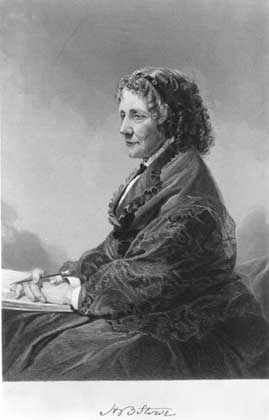The directory «Plots»
Beecher Stowe Harriet
(1811–1896)
«Uncle Tom’s Cabin»

American novelist and humanitarian, b. Litchfield, Conn. With her novel Uncle Tom’s Cabin, she stirred the conscience of Americans concerning slavery and thereby influenced the course of American history. The daughter of Lyman Beecher, pastor of the Congregational Church in Litchfield, and the sister of Henry Ward Beecher, Harriet grew up in an atmosphere of New England Congregational piety and, like all the Beechers, early developed an interest in theology and in schemes for improving humanity. In 1824 she went to Hartford, at first to study, later to teach in her sister Catherine’s school. When her father became head of Lane Theological Seminary in Cincinnati, she moved to that city with him and there began teaching again and writing. In 1836 she married Professor Calvin Ellis Stowe.
Cincinnati, a border city, was at the time torn with abolitionist conflicts. Harriet’s brothers were violently opposed to slavery, and she had seen its effects in Kentucky and had aided a runaway slave. However, it was not until the passage of the Fugitive Slave Act (1850) that she was moved to write on the subject. Uncle Tom’s Cabin, first published serially (1851–52) in an abolitionist paper, the National Era, was not intended as abolitionist propaganda, nor was it directed against the South, although slaveholders condemned the book as unfair; indeed, it presented some of the favorable aspects of slavery, but it also crystallized the sentiments of the North. In one year over 300,000 copies were sold, and its dramatization by G. L. Aiken had a long run. The book was translated into many foreign languages, and when Mrs. Stowe visited Europe in 1853 numerous honors were bestowed on her.
Her second novel of slavery, Dred (1856), while better constructed and more accurate, failed to recapture the warm characterization of the first. During the 1850s she worked vigorously for the antislavery effort, although she never allied herself with the abolitionists, whom she considered extremists. The mother of six children, she was constantly harassed by financial worries, for despite the great popularity of her books her earnings were never large, and she and her husband were unbusinesslike and overly generous. Interested in other reform movements, such as temperance and woman suffrage, she also wrote religious poems and articles for religious magazines and housekeeping manuals. Her works are generally given to sermonizing, but in The Minister’s Wooing (1859) and Old Town Folks (1869) she captures the New England of her childhood.
At her best, Stowe combined literary realism with evangelical fervor. A prolific writer whose works fill 16 volumes, she was chiefly popular because she so aptly expressed the sentiments of the 19th-century middle class. Her works reflect the great issues and events of her century: slavery, women’s position in society, the decline of Calvinism, the rise of industry and consumerism, and the birth of a great national literature.
Bulgaria, 1977, Uncle Tom’s Cabin
Nevis, 2010, Harriet Beecher Stowe
Nevis, 2010, Henri Dunant and writers
Sierra Leone, 2010, Henri Dunant and writers
USA, 2007, Harriet Beecher Stowe